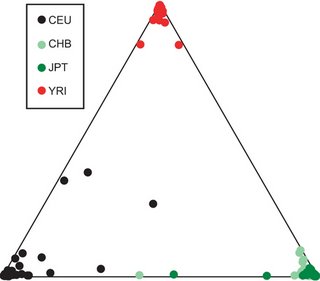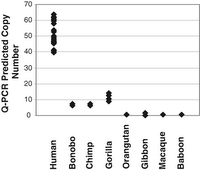Three schizophrenia genetics research consortia, each funded in part by NIMH, report separately on their genome-wide association studies online July 1, 2009, in the journal Nature. However, the SGENE, International Schizophrenia (ISC) and Molecular Genetics of Schizophrenia (MGS) consortia shared their results – making possible meta-analyses of a combined sample totaling 8,014 cases and 19,090 controls.From news.com.au:
All three studies implicate an area of Chromosome 6 (6p22.1), which is known to harbor genes involved in immunity and controlling how and when genes turn on and off. This hotspot of association might help to explain how environmental factors affect risk for schizophrenia. For example, there are hints of autoimmune involvement in schizophrenia, such as evidence that offspring of mothers with influenza while pregnant have a higher risk of developing the illness.
As well as pinpointing key immune system mutations, complementary discoveries from each consortium showed clearly that many small genetic variations combine in different ways to increase a person's risk of developing schizophrenia.From the deCODE news release:"If you look at any individual with schizophrenia no single gene is really strong, but put these genes together and you get a meaningful influence," Dr Cairns said.
So, while these three studies are a vindication of sorts for common variants, the greater part of the risk remains to be found in rare variants that are not captured by the 300K SNPs or so that were genotyped. But, by any means, this is a significant victory in the search for the hidden heritability."Genetics offers a unique window for better understanding diseases like schizophrenia because the brain and cognition are so little understood and so difficult to study. Discoveries such as these are crucial for teasing out the biology of the disease and making it possible for us to begin to develop drugs targeting the underlying causes and not just the symptoms of the disease. One of the reasons this study was so successful is its unprecendented size. Pooling our resources has yielded spectacular results, which is what the participants from three continents hoped for. At the same time, this study underscores the fact that rare variants may well carry a significant part of the genetic risk of schizophrenia, so our next task is to use the ever more affordable sequencing technologies to find more of them," said
Kari Stefansson , CEO of deCODE and corresponding author on the paper.In the first phase of the study, the deCODE-led SGENE consortium conducted a genome-wide scan of more than 300,000 SNPs in a total of 17,000 patients and controls from
England ,Finland ,Germany ,Iceland ,Italy andScotland . The 1500 SNPs with the best signal were then analyzed in 11,000 patients and controls from the International Schizophrenia Consortium (ISC) and the European-American portion of the Molecular Genetics of Schizophrenia studies (MGS). Twenty-five SNPs with strong suggestive correlation were then followed up in more than 20,000 patients and controls fromthe Netherlands ,Denmark ,Germany ,Hungary ,Norway ,Russia ,Finland andSpain . Bringing together the results of different consortia established he association between the the total of seven markers on chromosomes 6, 11, and 18 with increased risk of schizophrenia.
From the Stanford release:
Using commercially available "SNP chips" designed to detect those more-common variants, the investigators looked for differences between the DNA of people with schizophrenia versus the DNA of those without the disease. The scientists required that such differences achieve "genome-wide statistical significance." Here's why: If you flip a million coins, one at a time, you're going to see all kinds of seemingly miraculous events — say, 15 heads in a row — that may seem significant but are typical when you toss even a perfectly balanced coin so many times.
Shi's job was to devise analytical techniques to determine whether the "finding" of a SNP's greater likelihood among schizophrenics was real or spurious. The genomic region on chromosome 6 survived this rigorous statistical test.
"These findings show that our genetic methods are working, and that the genetic underpinnings of schizophrenia can be understood," said Levinson. "Similar methods have produced critical new discoveries in many other common diseases, once very large numbers of people could be studied. Now we see that the same approach works for psychiatric disorders like schizophrenia."
The three papers (in no particular order):
Nature doi:10.1038/nature08185
Common polygenic variation contributes to risk of schizophrenia and bipolar disorder
The International Schizophrenia Consortium
Abstract
Schizophrenia is a severe mental disorder with a lifetime risk of about 1%, characterized by hallucinations, delusions and cognitive deficits, with heritability estimated at up to 80%1, 2. We performed a genome-wide association study of 3,322 European individuals with schizophrenia and 3,587 controls. Here we show, using two analytic approaches, the extent to which common genetic variation underlies the risk of schizophrenia. First, we implicate the major histocompatibility complex. Second, we provide molecular genetic evidence for a substantial polygenic component to the risk of schizophrenia involving thousands of common alleles of very small effect. We show that this component also contributes to the risk of bipolar disorder, but not to several non-psychiatric diseases.
Link
Nature doi:10.1038/nature08186
Common variants conferring risk of schizophrenia
Hreinn Stefansson et al.
Abstract
Schizophrenia is a complex disorder, caused by both genetic and environmental factors and their interactions. Research on pathogenesis has traditionally focused on neurotransmitter systems in the brain, particularly those involving dopamine. Schizophrenia has been considered a separate disease for over a century, but in the absence of clear biological markers, diagnosis has historically been based on signs and symptoms. A fundamental message emerging from genome-wide association studies of copy number variations (CNVs) associated with the disease is that its genetic basis does not necessarily conform to classical nosological disease boundaries. Certain CNVs confer not only high relative risk of schizophrenia but also of other psychiatric disorders1, 2, 3. The structural variations associated with schizophrenia can involve several genes and the phenotypic syndromes, or the 'genomic disorders', have not yet been characterized4. Single nucleotide polymorphism (SNP)-based genome-wide association studies with the potential to implicate individual genes in complex diseases may reveal underlying biological pathways. Here we combined SNP data from several large genome-wide scans and followed up the most significant association signals. We found significant association with several markers spanning the major histocompatibility complex (MHC) region on chromosome 6p21.3-22.1, a marker located upstream of the neurogranin gene (NRGN) on 11q24.2 and a marker in intron four of transcription factor 4 (TCF4) on 18q21.2. Our findings implicating the MHC region are consistent with an immune component to schizophrenia risk, whereas the association with NRGN and TCF4 points to perturbation of pathways involved in brain development, memory and cognition.
Link
Nature doi:10.1038/nature08192
Common variants on chromosome 6p22.1 are associated with schizophrenia
Jianxin Shi et al.
Abstract
Schizophrenia, a devastating psychiatric disorder, has a prevalence of 0.5–1%, with high heritability (80–85%) and complex transmission1. Recent studies implicate rare, large, high-penetrance copy number variants in some cases2, but the genes or biological mechanisms that underlie susceptibility are not known. Here we show that schizophrenia is significantly associated with single nucleotide polymorphisms (SNPs) in the extended major histocompatibility complex region on chromosome 6. We carried out a genome-wide association study of common SNPs in the Molecular Genetics of Schizophrenia (MGS) case-control sample, and then a meta-analysis of data from the MGS, International Schizophrenia Consortium and SGENE data sets. No MGS finding achieved genome-wide statistical significance. In the meta-analysis of European-ancestry subjects (8,008 cases, 19,077 controls), significant association with schizophrenia was observed in a region of linkage disequilibrium on chromosome 6p22.1 (P = 9.54 times 10-9). This region includes a histone gene cluster and several immunity-related genes—possibly implicating aetiological mechanisms involving chromatin modification, transcriptional regulation, autoimmunity and/or infection. These results demonstrate that common schizophrenia susceptibility alleles can be detected. The characterization of these signals will suggest important directions for research on susceptibility mechanisms.
Link



